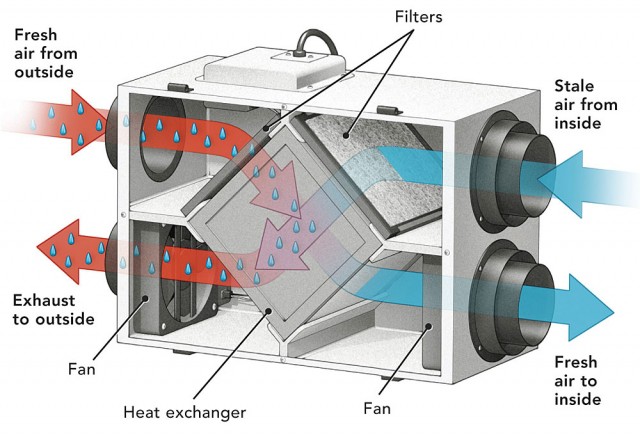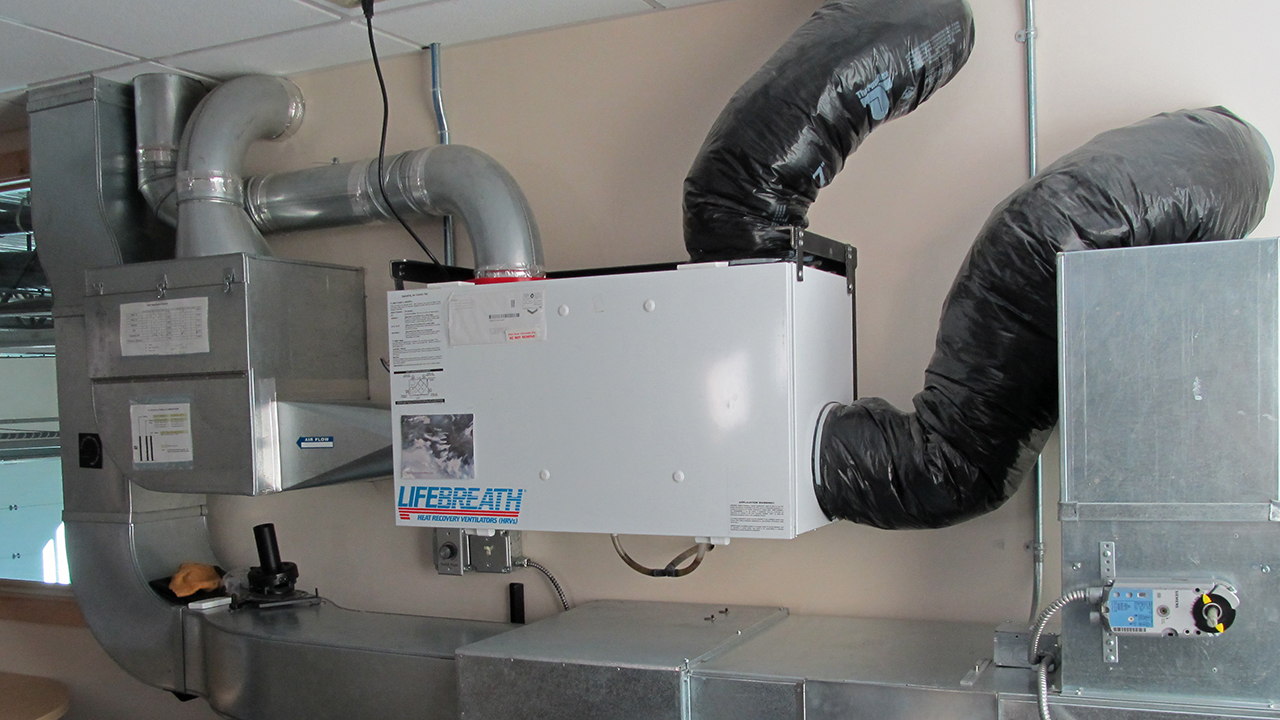Introducing the Secret Benefits and Uses of Heat Recovery Ventilation in Sustainable Layout
Heat Recovery Ventilation (HRV) systems play an essential function in sustainable layout. They promote a constant exchange of stale interior air with fresh outside air, significantly enhancing interior air high quality. Moreover, HRVs add to power effectiveness by reclaiming warm from tired air, which can lower energy costs. Comprehending the diverse benefits and applications of HRVs reveals their importance in modern style. What other advantages do these systems offer in the quest of sustainability?
Understanding Heat Recovery Ventilation Solutions
Heat recovery ventilation (HRV) systems are developed to boost indoor air high quality while minimizing power loss. These systems make use of a mechanical ventilation technique to exchange stagnant indoor air with fresh exterior air, ensuring a constant supply of tidy air. By recording heat from the exhaust air, HRVs precondition incoming air, reducing the demand on heating and cooling systems. This process not just enhances thermal comfort yet likewise adds to energy effectiveness in household and industrial structures. In addition, HRV systems assist control moisture levels and reduce interior pollutants, advertising a healthier living atmosphere. Their calculated application is important for accomplishing lasting design goals, as they supply an equilibrium in between power conservation and occupant well-being.
Exactly How HRV Solution Work
While lots of might know with air flow systems, recognizing just how warmth recuperation air flow (HRV) systems run is essential for valuing their advantages. HRV systems work by exchanging stale indoor air with fresh outdoor air while transferring heat in between both streams. This process occurs in a heat exchanger, where heat from the outgoing air warms up the inbound air during chillier months, lessening energy loss. On the other hand, in warmer months, the system can cool incoming air making use of the cooler outward bound air. HRVs are outfitted with fans to promote air movement and filters to eliminate particulates, making certain a constant, balanced ventilation process. This innovative layout not just improves energy performance however additionally adds to maintaining a comfortable interior setting.
Enhancing Indoor Air Top Quality
Interior air high quality can substantially influence health and wellness and health, making effective ventilation important in modern-day homes. Heat Recovery Ventilation (HRV) systems play a vital duty in keeping interior air high quality by continuously trading stale interior air with fresh exterior air. This process not just minimizes airborne contaminants yet likewise minimizes humidity degrees, which can result in mold and mildew growth and breathing issues. HRV systems filter incoming air, eliminating allergens and particulates, thereby offering a much healthier living atmosphere. Furthermore, these systems aid eliminate odors and unpredictable organic substances (VOCs) typically located in family products. By making certain a consistent flow of tidy air, HRV systems add to a total improved indoor atmosphere, advertising convenience and wellness for passengers.
Power Performance and Cost Financial Savings
Energy effectiveness attracts attention as a considerable benefit of Heat Recovery Ventilation (HRV) systems. By capturing and reusing the warm from worn down indoor air, HRVs reduce the power required for heating incoming fresh air, resulting in minimized power intake. This efficiency translates into lower energy expenses, providing significant cost savings for home owners and services alike. Additionally, HRV systems frequently get energy efficiency motivations and discounts, even more improving their monetary charm. With time, the preliminary investment in HRV innovation can cause a favorable roi with reduced energy costs. Consequently, the assimilation of HRV systems not just promotes lasting layout however likewise supplies a functional service for accomplishing long-term energy financial savings and financial advantages.
Ecological Benefits of HRV

A multitude of environmental advantages emerges from the execution of Heat Recovery Ventilation (HRV) systems. By successfully moving warm from exhaust air to incoming fresh air, HRVs considerably reduce the power needed for heating and cooling spaces. This power effectiveness equates to lower greenhouse gas emissions, adding to a reduction in the general carbon footprint of structures. Furthermore, HRV systems improve interior air top quality by continually distributing fresh air, thus reducing the concentration of indoor contaminants and allergens. In addition, the decrease in energy consumption help in saving natural deposits, read review making HRVs a necessary component of lasting design. Overall, the ecological benefits of HRVs play an important duty in promoting a much healthier planet and fostering environment-friendly structure techniques.
Versatile Applications in Modern Design
Heat recovery ventilation (HRV) systems are significantly being incorporated right into both household and commercial architectural tasks. In domestic setups, HRVs enhance interior air quality while optimizing power performance. On the other hand, in commercial spaces, these systems enhance ventilation strategies, demonstrating their adaptability in modern architectural applications.
Residential Projects Integration
While contemporary style increasingly emphasizes sustainability, the assimilation of warmth recovery ventilation systems in domestic jobs has actually arised as a practical service for boosting interior air top quality and power efficiency. These systems efficiently transfer heat from exhaust air to inbound fresh air, decreasing energy loss and reducing home heating or cooling down demands. In new builds and retrofits alike, heat recuperation ventilation can be effortlessly integrated, supplying homeowners with a much healthier living environment while lowering energy prices. In addition, with raising understanding of environmental impacts, more article engineers and home builders are identifying the lasting advantages of these systems. Therefore, heat recovery air flow has actually ended up being a vital part of sustainable property style, showcasing flexibility and commitment to environmentally friendly methods.
Industrial Spaces Optimization
As modern-day business areas develop to satisfy the demands of sustainability and effectiveness, the implementation of warm recovery ventilation systems emerges as a vital approach for maximizing indoor environments. These systems help with the exchange of stale indoor air with fresh outside air while redeeming heat, significantly minimizing power usage. This not just enhances convenience for residents however additionally helps in lowering functional costs. Flexible applications can be observed in workplaces, retail areas, and universities, where air quality and temperature level control are extremely important. Furthermore, incorporating heat recuperation air flow straightens with eco-friendly structure qualifications, even more advertising environmental duty. Ultimately, embracing such systems in business architecture not just adds to sustainability goals yet also promotes much healthier, much more efficient rooms for customers.
Integrating HRV Into Sustainable Style Practices
Incorporating warmth recuperation air flow (HRV) systems right into lasting layout methods supplies significant advantages in power performance and interior air top quality. By making use of HRV, developers can develop cost-effective solutions that not just lower power intake yet likewise improve the overall comfort of indoor environments. This placement with sustainability objectives settings HRV as a crucial part in contemporary architectural strategies.
Energy Performance Enhancement
By including heat healing air flow (HRV) systems into sustainable style techniques, engineers and builders can considerably boost power efficiency in contemporary buildings. HRV systems function by catching warm from outbound stale air and moving it to inbound fresh air, reducing the energy required for heating or cooling interior spaces. This procedure not only reduces dependence on typical cooling and heating systems however also decreases overall power consumption. Additionally, HRV systems can aid preserve a regular interior temperature level, reducing peak energy needs. By incorporating these systems, buildings can attain substantial reductions in energy costs and carbon impacts, aligning with sustainability goals. Eventually, HRV innovation stands for a functional solution for improving power effectiveness in the constructed environment, promoting even more accountable source use.
Indoor Air Top Quality Improvement
Exactly how can warmth recovery air flow (HRV) systems add to superior indoor air quality in contemporary buildings? HRV systems successfully exchange stagnant indoor air with fresh outside air while recouping heat energy, reducing temperature level variations. This process decreases the focus of interior toxins, such as volatile natural compounds (VOCs), allergens, and dampness, which can deteriorate air quality and effect passenger wellness. By keeping suitable moisture degrees and guaranteeing a constant supply of clean air, HRVs aid create a healthier indoor atmosphere. Furthermore, these systems can be incorporated right into lasting design practices, promoting energy efficiency along with boosted air high quality. HRV Heat Recovery Ventilation. HRV modern technology plays a crucial duty in progressing total owner convenience and wellness in contemporary architectural layouts.
Cost-Effective Style Solutions

Frequently Asked Inquiries
What Upkeep Is Required for Heat Recovery Ventilation Solutions?

Maintenance for warm recovery ventilation systems generally entails routine filter substitutes, cleaning of warmth exchangers, examination of fans and air ducts, and ensuring appropriate water drainage. These jobs help preserve performance and lengthen the system's lifespan in time.
Can HRV Systems Be Mounted in Existing Structures?
Heat recovery ventilation systems can undoubtedly be set up in existing buildings. HRV Heat Recovery Ventilation. Retrofitting calls for cautious preparation and assessment of the structure's layout, ensuring compatibility with existing systems while making the most of energy performance and indoor air quality
Exactly How Do HRV Equipment Impact Noise Levels Inside?
HRV systems can influence interior sound degrees by introducing noise from outside sources with air flow. Top quality installments often integrate sound-dampening features, lessening sound effect while giving reliable air exchange and preserving comfort inside your home.
Are There Any Drawbacks to Utilizing HRV Solutions?
The drawbacks of utilizing HRV systems include potential high initial prices, upkeep difficulties, and the possibility of decreased indoor air quality if filters are sporadically altered, which could lead to concerns with moisture levels.
How Do I Select the Right HRV System for My Requirements?
Choosing the appropriate warmth healing ventilation system entails reviewing certain needs, such as constructing dimension, climate, and energy efficiency objectives. Furthermore, evaluating system features, installment needs, and maintenance considerations is crucial for peak efficiency and fulfillment.